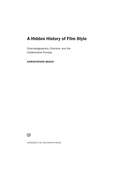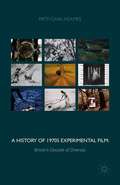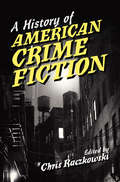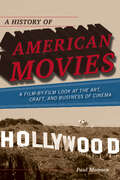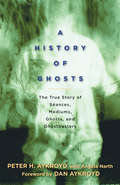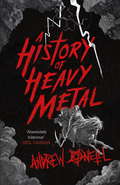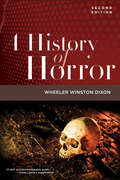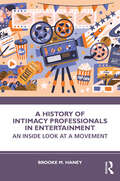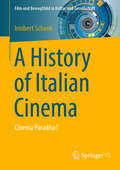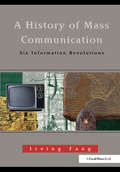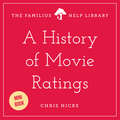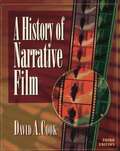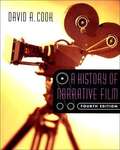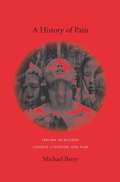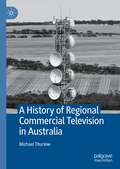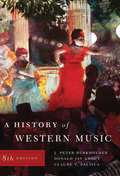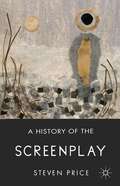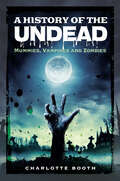- Table View
- List View
A Helluva High Note: Surviving Life, Love, and American Idol
by Kara DioGuardiOver the years, award-winning hitmaker, savvy record executive, successful music publisher and former American Idol judge Kara DioGuardi has worked with the best. Her songs have been recorded by such superstars as Pink, Carrie Underwood, Britney Spears, Christina Aguilera, Kelly Clarkson, Gwen Stefani, Santana, Steven Tyler, Celine Dion and many others. But success wouldn’t have happened for this songwriter, artist and producer without the darker times of defeat. Now, in this daringly honest memoir, DioGuardi reveals everything she’s learned about living, creating, loving, stumbling, picking herself up again and ultimately succeeding. And, of course, she hares behind-the-scenes stories from her years on American Idol, including the real truth about her departure from the show. Passionate, wide and funny, A Helluva High Note inspires readers to find, develop and follow their own true voice.
A Hidden History of Film Style
by Christopher BeachThe image that appears on the movie screen is the direct and tangible result of the joint efforts of the director and the cinematographer. A Hidden History of Film Style is the first study to focus on the collaborations between directors and cinematographers, a partnership that has played a crucial role in American cinema since the early years of the silent era. Christopher Beach argues that an understanding of the complex director-cinematographer collaboration offers an important model that challenges the pervasive conventional concept of director as auteur. Drawing upon oral histories, early industry trade journals, and other primary materials, Beach examines key innovations like deep focus, color, and digital cinematography, and in doing so produces an exceptionally clear history of the craft. Through analysis of several key collaborations in American cinema from the silent era to the late twentieth century--such as those of D. W. Griffith and Billy Bitzer, William Wyler and Gregg Toland, and Alfred Hitchcock and Robert Burks--this pivotal book underlines the importance of cinematographers to both the development of cinematic technique and the expression of visual style in film.
A History Of Narrative Film
by David CookA trusted reference, a popular teaching text, and a well-written history is now bolder, briefer, and better than ever. <P><P> Sophisticated in its analytical content, current in its coverage, and informed throughout by fascinating historical and cultural contexts, A History of Narrative Film is one of the most respected and widely read texts in film studies. This Fifth Edition features a new chapter on twenty-first century film, and includes refreshed coverage of contemporary digital production, distribution, and consumption of film. Now 20% shorter, with new four-color design and an updated art program, A History of Narrative Film is also the only film history text available as an ebook.
A History of 1970s Experimental Film: Britain's Decade Of Diversity
by Patti Gaal-HolmesThis comprehensive historical account demonstrates the rich diversity in 1970s British experimental filmmaking, acting as a form of reclamation for films and filmmakers marginalized within established histories. An indispensable book for practitioners, historians and critics alike, it provides new interpretations of this rich and diverse history.
A History of American Crime Fiction
by Chris RaczkowskiA History of American Crime Fiction places crime fiction within a context of aesthetic practices and experiments, intellectual concerns, and historical debates generally reserved for canonical literary history. Toward that end, the book is divided into sections that reflect the periods that commonly organize American literary history, with chapters highlighting crime fiction's reciprocal relationships with early American literature, romanticism, realism, modernism and postmodernism. It surveys everything from 17th-century execution sermons, the detective fiction of Harriet Spofford and T. S. Eliot's The Waste Land, to the films of David Lynch, HBO's The Sopranos, and the podcast Serial, while engaging a wide variety of critical methods. As a result, this book expands crime fiction's significance beyond the boundaries of popular genres and explores the symbiosis between crime fiction and canonical literature that sustains and energizes both.
A History of American Movies: A Film-by-Film Look at the Art, Craft, and Business of Cinema
by Paul MonacoIn A History of American Movies: A Film-by-Film Look at the Art, Craft and Business of Cinema, Paul Monaco provides a survey of the narrative feature film from the 1920s to the present. The book focuses on 170 of the most highly regarded and recognized feature films selected by the Hollywood establishment: each Oscar winner for Best Picture, as well as those voted the greatest by members of the American Film Institute. By focusing on a select group of films that represent the epitome of these collaborations, Monaco provides an essential history of one of the modern world's most complex and successful cultural institutions: Hollywood. Divided into three sections, "Classic Hollywood, 1927-1948," "Hollywood In Transition, 1949-1974," and "The New Hollywood, 1975 To The Present," Monaco examines some of the most memorable works in cinematic history, including The General, Wings, Bringing Up Baby, Gone with the Wind, Citizen Kane, Casablanca, On the Waterfront, The Searchers, Psycho, West Side Story, The Godfat
A History of Ghosts: The True Story of Séances, Mediums, Ghosts, and Ghostbusters
by Peter H. Aykroyd Angela NarthPeter Aykroyd spent his childhood watching his family's parlor séances through the crack of a basement door. Here, for the first time, Aykroyd tells the strange and delightful story that inspired his son, Dan, to make the mega-hit, Ghostbusters. Part history, part family legend, A History of Ghosts starts in 1848 in upstate New York, where the spiritualist craze first began. Aykroyd introduces the reader to notable mediums while telling the story of the development of spiritualism, interweaving a personal history marked by a fascination with ghosts and spirits with the larger narrative about the role the paranormal has played in our culture. Such legendary figures as Sir Arthur Conan Doyle and Harry Houdini appear and vanish. Everyone loves a good ghost story. Successful TV shows such as Medium and Ghost Hunters are proof that our national obsession with ghosts is here to stay. Millions of Americans believe in the paranormal—and even skeptics have heard a bump in the night and suspected it might be something supernatural.
A History of Heavy Metal
by Andrew O'NeillThe history of heavy metal brings brings us extraordinary stories of larger-than-life characters living to excess, from the household names of Ozzy Osbourne, Lemmy, Bruce Dickinson and Metallica (SIT DOWN, LARS!), to the brutal notoriety of the underground Norwegian black metal scene and the New Wave Of British Heavy Metal. It is the story of a worldwide network of rabid fans escaping everyday mundanity through music, of cut-throat corporate arseholes ripping off those fans and the bands they worship to line their pockets. <p><p>The expansive pantheon of heavy metal musicians includes junkies, Satanists and murderers, born-again Christians and teetotallers, stadium-touring billionaires and toilet-circuit journeymen. Award-winning comedian and life-long heavy metal obsessive Andrew O'Neill has performed his History of Heavy Metal comedy show to a huge range of audiences, from the teenage metalheads of Download festival to the broadsheet-reading theatre-goers of the Edinburgh Fringe. <p><p>Now, in his first book, he takes us on his own very personal and hilarious journey through the history of the music, the subculture, and the characters who shaped this most misunderstood genre of music.
A History of Heavy Metal: 'Absolutely hilarious' – Neil Gaiman
by Andrew O'Neill'Absolutely hilarious' - Neil Gaiman'One of the funniest musical commentators that you will ever read . . . loud and thoroughly engrossing' - Alan Moore'A man on a righteous mission to persuade people to "lay down your souls to the gods rock and roll".' - The Sunday Times'As funny and preposterous as this mighty music deserve' - John HiggsThe history of heavy metal brings brings us extraordinary stories of larger-than-life characters living to excess, from the household names of Ozzy Osbourne, Lemmy, Bruce Dickinson and Metallica (SIT DOWN, LARS!), to the brutal notoriety of the underground Norwegian black metal scene and the New Wave Of British Heavy Metal. It is the story of a worldwide network of rabid fans escaping everyday mundanity through music, of cut-throat corporate arseholes ripping off those fans and the bands they worship to line their pockets. The expansive pantheon of heavy metal musicians includes junkies, Satanists and murderers, born-again Christians and teetotallers, stadium-touring billionaires and toilet-circuit journeymen. Award-winning comedian and life-long heavy metal obsessive Andrew O'Neill has performed his History of Heavy Metal comedy show to a huge range of audiences, from the teenage metalheads of Download festival to the broadsheet-reading theatre-goers of the Edinburgh Fringe. Now, in his first book, he takes us on his own very personal and hilarious journey through the history of the music, the subculture, and the characters who shaped this most misunderstood genre of music.
A History of Heavy Metal: 'Absolutely hilarious' – Neil Gaiman
by Andrew O'Neill'Absolutely hilarious' - Neil Gaiman'One of the funniest musical commentators that you will ever read . . . loud and thoroughly engrossing' - Alan Moore'Relentlessly energetic and frequently hilarious' - The Herald'A man on a righteous mission to persuade people to "lay down your souls to the gods rock and roll"' - The Sunday Times'A love letter to Heavy Metal' - BBC RADIO 4 'As funny and preposterous as this mighty music deserve' - John HiggsThe history of heavy metal brings brings us extraordinary stories of larger-than-life characters living to excess, from the household names of Ozzy Osbourne, Lemmy, Bruce Dickinson and Metallica (SIT DOWN, LARS!), to the brutal notoriety of the underground Norwegian black metal scene and the New Wave Of British Heavy Metal. It is the story of a worldwide network of rabid fans escaping everyday mundanity through music, of cut-throat corporate arseholes ripping off those fans and the bands they worship to line their pockets. The expansive pantheon of heavy metal musicians includes junkies, Satanists and murderers, born-again Christians and teetotallers, stadium-touring billionaires and toilet-circuit journeymen. Award-winning comedian and life-long heavy metal obsessive Andrew O'Neill has performed his History of Heavy Metal comedy show to a huge range of audiences, from the teenage metalheads of Download festival to the broadsheet-reading theatre-goers of the Edinburgh Fringe. Now, in his first book, he takes us on his own very personal and hilarious journey through the history of the music, the subculture, and the characters who shaped this most misunderstood genre of music.
A History of Horror, 2nd Edition
by Wheeler Winston DixonEver since horror leapt from popular fiction to the silver screen in the late 1890s, viewers have experienced fear and pleasure in exquisite combination. Wheeler Winston Dixon's fully revised and updated A History of Horror is still the only book to offer a comprehensive survey of this ever-popular film genre. Arranged by decades, with outliers and franchise films overlapping some years, this one-stop sourcebook unearths the historical origins of characters such as Dracula, Frankenstein, and the Wolfman and their various incarnations in film from the silent era to comedic sequels. In covering the last decade, this new edition includes coverage of the resurgence of the genre, covering the swath of new groundbreaking horror films directed by women, Black and queer horror films, and a new international wave in body horror films. A History of Horror explores how the horror film fits into the Hollywood studio system, how the distribution and exhibition of horror films have changed in a post-COVID world, and how its enormous success in American and European culture expanded globally over time. Dixon examines key periods in the horror film-in which the basic precepts of the genre were established, then banished into conveniently reliable and malleable forms, and then, after collapsing into parody, rose again and again to create new levels of intensity and menace. A History of Horror, supported by rare stills from classic films, brings over sixty timeless horror films into frightfully clear focus, zooms in on today's top horror Web sites, and champions the stars, directors, and subgenres that make the horror film so exciting and popular with contemporary audiences.
A History of Intimacy Professionals in Entertainment: An Inside Look at a Movement
by Brooke M. HaneyA History of Intimacy Professionals in Entertainment is the first book that explores the evolution of intimacy coordinators, choreographers and directors in the performing arts, highlighting the history of their critical role in fostering safe(r) and respectful environments on set and in theaters.Readers will gain a deep understanding of the history and importance of intimacy work in the entertainment industry, as told by an insider, along with insights into the creation of best practices and protocols and the emergence of training organizations. Focused primarily on the USA, part one dives into the cultural events that impacted and galvanized the role of intimacy professionals, like TIME'S UP, #MeToo, Black Lives Matter and the Covid-19 pandemic. It also looks at how unions and the press responded to and affected the movement, as well as other communities that influenced the creation of protocols. Part two consists of interviews with global thought leaders, analysis and resources. A love letter to the intimacy industry, A History of Intimacy Professionals in Entertainment is meant for producers, directors, actors, educators, students in performing arts programs and anyone who advocates for safer practices in entertainment. Intimacy professionals will also greatly benefit from having the knowledge of how we got here recorded.
A History of Italian Cinema: Cinema Paradiso? (Film und Bewegtbild in Kultur und Gesellschaft)
by Irmbert SchenkThis book provides a complete description of the development of Italian film and cinema from its beginnings in 1895 until today. Special emphasis is placed on those periods in which Italian film history became aesthetically decisive for world cinematography: silent film of the 1910s, neorealism after World War II, and auteur and genre cinema around 1960. And then on the multifaceted development up to the present day, which still guarantees films from Italy a significant place in international cinema. The chapters are introduced with compact descriptions of Italy's political and social history and the institutional formation of film and cinema. This is the basis for the extensive examination of genres and films. The film analyses also include a look at the reception by the audiences.
A History of Mass Communication: Six Information Revolutions
by Irving FangThis exciting new text traces the common themes in the long and complex history of mass communication. It shows how the means of communicating grew out of their eras, how they developed, how they influenced the societies of those eras, and how they have continued to exert their influence upon subsequent generations. The book is divided into six periods which are identified as 'Information Revolutions' writing, printing, mass media, entertainment, the 'toolshed' (which we call 'home' now), and the Information Highway. In looking at the ways in which the tools of communication have influenced and been influenced by social change, A History of Mass Communication provides students of media and journalism with a strong sense of the way their chosen field affects how society functions. Providing a broad-based approach to media history, Dr. Fang encourages the reader to take a careful look at where our culture is headed through the tools we use to communicate with one another.A History of Mass Communication is not only the most current text on communication history, but also an invaluable resource for anyone interested in how methods of communication affect society.
A History of Movie Ratings
by Chris HicksThe wire-thin line that separates movies rated PG and R has been crossed over so many times in both directions that industry observers are questioning whether the rating system carries any validity at all. Just where did this system come from? And who's been trusted with dishing out the ratings anyway? As a movie reviewer for more than thirty years, author Chris Hicks knows a thing or two about Hollywood. His masterful synopsis of CARA, the MPAA, and the mess we're in today will make you think twice before you take a film rating at face value.
A History of Narrative Film (3rd ed.)
by David A. CookThe most comprehensive and complete history of international cinema in print.
A History of Narrative Film (4th edition)
by David A. CookSuitable as both a reference and a teaching text, this volume integrates film history and aesthetics with an analysis of the technological, social, and economic contexts of world cinema. It concentrates on narrative film, excluding documentary cinema, animated cinema, and the experimental avant-garde. The fourth edition features a new chapter on computer generated imaging as well as a new section of plates illustrating the development of color film technologies. Annotation ©2004 Book News, Inc., Portland, OR (booknews.com)
A History of Pain
by Michael BerryThe portrayal of historical atrocity in fiction, film, and popular culture can reveal much about the function of individual memory and the shifting status of national identity. In the context of Chinese culture, films such as Hou Hsiao-hsien's City of Sadness and Lou Ye's Summer Palace and novels such as Ye Zhaoyan's Nanjing 1937: A Love Story and Wang Xiaobo's The Golden Age collectively reimagine past horrors and give rise to new historical narratives.Michael Berry takes an innovative look at the representation of six specific historical traumas in modern Chinese history: the Musha Incident (1930); the Rape of Nanjing (1937-38); the February 28 Incident (1947); the Cultural Revolution (1966-76); Tiananmen Square (1989); and the Handover of Hong Kong (1997). He identifies two primary modes of restaging historical violence: centripetal trauma, or violence inflicted from the outside that inspires a reexamination of the Chinese nation, and centrifugal trauma, which, originating from within, inspires traumatic narratives that are projected out onto a transnational vision of global dreams and, sometimes, nightmares.These modes allow Berry to connect portrayals of mass violence to ideas of modernity and the nation. He also illuminates the relationship between historical atrocity on a national scale and the pain experienced by the individual; the function of film and literature as historical testimony; the intersection between politics and art, history and memory; and the particular advantages of modern media, which have found new means of narrating the burden of historical violence.As Chinese artists began to probe previously taboo aspects of their nation's history in the final decades of the twentieth century, they created texts that prefigured, echoed, or subverted social, political, and cultural trends. A History of Pain acknowledges the far-reaching influence of this art and addresses its profound role in shaping the public imagination and conception-as well as misconception-of modern Chinese history.
A History of Pain: Trauma in Modern Chinese Literature and Film (Global Chinese Culture)
by Michael BerryThe portrayal of historical atrocity in fiction, film, and popular culture can reveal much about the function of individual memory and the shifting status of national identity. In the context of Chinese culture, films such as Hou Hsiao-hsien's City of Sadness and Lou Ye's Summer Palace and novels such as Ye Zhaoyan's Nanjing 1937: A Love Story and Wang Xiaobo's The Golden Age collectively reimagine past horrors and give rise to new historical narratives.Michael Berry takes an innovative look at the representation of six specific historical traumas in modern Chinese history: the Musha Incident (1930); the Rape of Nanjing (1937-38); the February 28 Incident (1947); the Cultural Revolution (1966-76); Tiananmen Square (1989); and the Handover of Hong Kong (1997). He identifies two primary modes of restaging historical violence: centripetal trauma, or violence inflicted from the outside that inspires a reexamination of the Chinese nation, and centrifugal trauma, which, originating from within, inspires traumatic narratives that are projected out onto a transnational vision of global dreams and, sometimes, nightmares. These modes allow Berry to connect portrayals of mass violence to ideas of modernity and the nation. He also illuminates the relationship between historical atrocity on a national scale and the pain experienced by the individual; the function of film and literature as historical testimony; the intersection between politics and art, history and memory; and the particular advantages of modern media, which have found new means of narrating the burden of historical violence. As Chinese artists began to probe previously taboo aspects of their nation's history in the final decades of the twentieth century, they created texts that prefigured, echoed, or subverted social, political, and cultural trends. A History of Pain acknowledges the far-reaching influence of this art and addresses its profound role in shaping the public imagination and conception-as well as misconception-of modern Chinese history.
A History of Pantomime
by Maureen HughesEach Christmas entire families in the UK troop off to see, what one could almost say is 'the obligatory'. annual entertainment, known as Pantomime. It is a traditional, seasonal way of life for the British envied the world over, and one which only the British seem to understand! Pantomime serves both to entertain and to introduce each new generation to the joys of theatre in the most unique of ways, for this is not a type of theatre one merely watches, but one in which the audience participate often in the most seemingly boisterous and bizarre of ways. The whole experience is steeped in tradition, traditions which only the British seem to understand, which is probably why we are proud to call it a 'British Experience.'In A History of Pantomime Maureen Hughes takes a brief look at the history of Pantomime as well as taking a humorous look at some of the above mentioned traditions; she also gives a synopsis of each of the well-known Pantomimes whilst exploring the eccentric world of the characters who appear in them. There is also a short piece on just some of the most well-known and loved of the actors who each Christmas take on the part of Pantomime Dames across the UK, as well as a look at others who have contributed to this magical world of fun and eccentricity. It is thought by some to be frivolous and pointless piece of theatre, but a browse through this informative book and you will soon find that Pantomime is an art form all of its own, requiring the most dedicated and talented of actors/actresses who are prepared to honour and perpetuate this wonderful tradition as it is passed down from one generation to the next.As seen in The Telegraph and the Sunday Post (Glasgow).
A History of Regional Commercial Television in Australia
by Michael ThurlowThis book is the first history of commercial television in regional Australia, where diverse communities are spread across vast distances and multiple time zones. The first station, GLV Latrobe Valley, began broadcasting in December 1961. By the late 1970s, there were 35 independent commercial stations throughout regional Australia, from Cairns in the far north-east to Bunbury in the far south-west. Based on fine-grained archival research and extensive interviews, the book examines the key political, regulatory, economic, technological, industrial, and social developments which have shaped the industry over the past 60 years. Regional television is often dismissed as a mere extension of – or footnote to – the development of Australia’s three metropolitan commercial television networks. Michael Thurlow’s study reveals an industry which, at its peak, was at the economic and social heart of regional communities, employing thousands of people and providing vital programming for viewers in provincial cities and small towns across Australia.
A History of Romanian Theatre from Communism to Capitalism: Children of a Restless Time
by Cristina ModreanuA History of Romanian Theatre from Communism to Capitalism analyses the last three decades of Romanian theatre and connects it to the international stage. Cristina Modreanu questions the relationship between artists and power, both before 1989, behind the Iron Curtain, and in the current global political context, with nationalism manifesting itself in Eastern Europe, as seen in the critical work of Romanian theatre makers. This study covers the complex cases of theatre makers such as Lucian Pintilie, Liviu Ciulei and Andrei Șerban, who built their international careers in exile, and the most innovative Romanian artists of today, such as Silviu Purcărete, Mihai Măniuţiu, Gianina Cărbunariu, Radu Afrim, and Bogdan Georgescu, who reached the status of transglobal artists. Filling a considerable gap in Romanian theatre discourse, this book will be of a great interest to students and scholars of contemporary theatre and history.
A History of Western Music (8th edition)
by J. Peter Burkholder Donald Jay Grout Claude V. PaliscaThe Eighth Edition of A History of Western Music is a vivid, accessible, and richly contextual view of music in Western culture.
A History of the Screenplay
by Steven PriceThe screenplay is currently the focus of extensive critical re-evaluation, however, as yet there has been no comprehensive study of its historical development. International in scope and placing emphasis on the development and variety of screenplay texts themselves, this book will be an important and innovative addition to the current literature.
A History of the Undead: Mummies, Vampires and Zombies
by Charlotte BoothA history of Western culture’s fascination with undead creatures in film and television.Are you a fan of the undead? Watch lots of mummy, zombie and vampire movies and TV shows? Have you ever wondered if they could be “real?”This book, A History of the Undead, unravels the truth behind these popular reanimated corpses.Starting with the common representations in Western media through the decades, we go back in time to find the origins of the myths. Using a combination of folklore, religion and archaeological studies we find out the reality behind the walking dead. You may be surprised at what you find . . .

